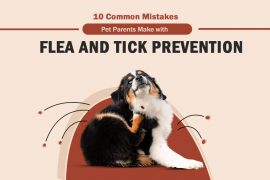Is your dog experiencing loss of appetite, vomiting, or diarrhea? It can be due to worms!
Intestinal worms are a leading health issue for dogs. It is found that 34% of dogs have intestinal worms, and almost all dogs get infected with worms at some stage in their lives. If left unattended and untreated, worms can lead to serious health complications for your furry pet. Moreover, humans can also contract worms in rare cases. That is why it is important to look after your pet’s health and ensure their safety and protection from worm infections.
In this blog, we will cover everything you must know to save your loved pet from catching intestinal worms. So, without further ado, let’s get started!
Common Intestinal Worms in Dogs – How Do They Get Worms
There are four types of intestinal worms that commonly occur in dogs. It includes:
- Roundworms
- Hookworms
- Whipworms
- Tapeworms
In order to treat and prevent the occurrence of these worms in your dogs, it’s crucial to have some background knowledge on each type of worm. Understanding their life cycle, symptoms, and transmission methods will help you take the necessary steps to protect your pet.
1. Roundworms

Species: Toxocara canis, Toxoscaris leonine
Roundworms are the most commonly occurring worms in dogs, especially in puppies. These worms are white, firm, round, look like spaghetti, and live in the intestinal tract of the host. These worms can be found in dogs’ poop.
Life Cycle and Transmission:
Dogs get roundworms by ingesting roundworm larvae found in contaminated soil, water, or infected prey. These larvae travel to the dog’s liver for maturation. Further, they travel to the dog’s lungs to become adults. Further they are coughed up or swallowed to reach the intestine. The adult roundworms live in the dog’s intestine and reproduce to lay eggs. The eggs are shed into the dog’s poop and develop into larvae. The cycle repeats when a healthy dog takes up larvae.
Puppies may get roundworm larvae from the mother during the gestational period as well as from the mother’s milk when feeding.
Signs and Symptoms:
- Diarrhea
- Vomiting
- Coughing
- Weight loss
- Dull hair coat
- Rounded, pot-belly appearance
Diagnosis:
- Fecal flotation: A lab test involving the testing of a sample of stool by a vet.
Treatments*:
- Drontal Allwormer
- Triworm-D
- Paragard Allwormer
- Panacur
- Popantel Allwormer
- Cazitel Flavored Allwormer
*Dosage: As suggested by your vet
2. Hookworms

Species: Ancylostoma caninum, Ancylostoma braziliense, and Ancylostoma ceylanicum
Hookworms are more fatal worms that attach themselves to the walls of the intestines of your pet and suck blood. These are short, round, and have teeth. The worms are smaller in size and do not appear in stool.
Life Cycle and Transmission:
The hookworm lifecycle is similar to that of roundworms. Its larvae are ingested by a healthy dog from contaminated food, water, or soil. The larvae then travel to the small intestines and develop into mature hookworms. Some larvae also travel to the dog’s lungs for maturation. Later they are coughed up or swallowed and reach to the intestines. The adult hookworms mate in the dog’s intestines and lay eggs. These eggs are shed in dog’s stools. When another healthy dog takes up larvae from the contaminated sources, its life cycle continues.
Puppies may also get the larvae from the mother during the gestational period and from the mother’s milk.
Signs and Symptoms:
- Anemia
- Weakness
- Weight loss
- Pale mucous membranes
- Diarrhea
- Blood in the stool
Diagnosis:
- Fecal flotation: Same test used for roundworms.
Treatments*:
- Drontal Allwormer
- Triworm-D
- Paragard Allwormer
- Panacur
- Popantel Allwormer
- Cazitel Flavored Allwormer
*Dosage: As suggested by your vet
3. Whipworms

Species: Trichuris vulpis
Whipworms live in the large intestine (cecum) of dogs. The worms remain attached to the wall of the intestines, with their heads embedded inside. Due to their unique whip-like head structure and tapered body, they are called whipworms.
Life Cycle and Transmission:
The whipworm eggs are usually found in contaminated soil and water due to their long dormant lives. When ingested by a dog, the eggs hatch into larvae in the small intestines. They are further passed into the large intestine and develop into adults. The adult whipworms reproduce in the intestine, and the eggs are shed in the stool. The cycle continues when another dog takes up the eggs.
Signs and Symptoms (rare, hard to detect):
- Bloody diarrhea
- Anemia
- Dry tongue and skin
Diagnosis:
- Fecal flotation: Same test used for roundworms. Lack of eggs in the stool makes the diagnosis tough.
Treatments*:
- Drontal allwormer
- Triworm-D
- Paragard allwormer
- Panacur
- Popantel allwormer
- Cazitel flavored allwormer
*Dosage: As suggested by your vet
4. Tapeworms

Species: Dipylidium canium, Taenia pisiformis, Echinococcus granulosus, and Echinococcus multilocularis
Tapeworms are intestinal worms that are long, flat (tape-like) worms that attach to the small intestine walls.
Life Cycle and Transmission:
Tapeworms are usually transmitted due to flea infestations. The fleas are vectors for tapeworm eggs and larvae. Moreover, adult tapeworms are also found in the guts of fleas. When dogs ingest fleas, they also consume tapeworms. The tapeworms then attach to the small intestines and grow into segments. They also shed eggs in the stool, which gets transmitted to a healthy dog via fleas.
The transmission may occur via fleas from one pet to another.
Signs and Symptoms:
- Appearance of rice-like segments around anus
- Rice-like segments in the stool
Diagnosis:
- Close inspection of the pet’s anus and stools
Treatments*:
- Droncit Tapewormer
- Drontal Plus
- Triworm-D
- Paragard Allwormer
- Panacur
- Popantel Allwormer
- Cazitel Flavored Allwormer
*Dosage: As suggested by your vet
How to Treat and Prevent Intestinal Worms in Dogs
It is essential to regularly deworm your dog to prevent and treat intestinal worms. Consulting a vet is recommended to determine the appropriate deworming schedule and medication for your dog.
There are various types of treatments available for dogs that protect against some or all types of intestinal worms. These treatments are available in oral and topical forms and should be administered as suggested by your vet.
Deworming Schedule
Dogs and puppies must receive a deworming treatment as per a schedule recommended by your vet. Usually, dogs and puppies are dewormed according to the given schedule:
| Puppies | Puppies should be wormed every 2 weeks, from birth until 12 weeks of age. Then, monthly until the age of six months. |
| Adults | Adult dogs should be dewormed every six months. However, some vets also suggest deworming every 3 months if the dog is active. |
| Breeding Females | Breeding females are dewormed during mating and before giving birth, as advised by the vet. |
Furthermore, controlling fleas is important to combat intestinal worm infection and prevent its prevalence. Fleas are responsible for transmitting tapeworms to dogs. Regular use of flea prevention products, such as topical treatments or collars, can help reduce the risk of tapeworm infection.
Additionally, practicing good hygiene, such as regularly cleaning your dog’s bedding and living areas, can also aid in preventing the spread of intestinal worms.
Bottom Line:
Worms can cause serious complications for your furry dog. It not only causes discomfort for your pets but can also cause nutritional deficiencies, weight loss, and even organ damage if left untreated. Therefore, it is crucial to take proactive measures to prevent worm infestations in dogs.
By regularly deworming, using flea prevention products, and practicing good hygiene, you can significantly reduce the risk of intestinal worm infections and ensure the overall health and well-being of your furry friend.





